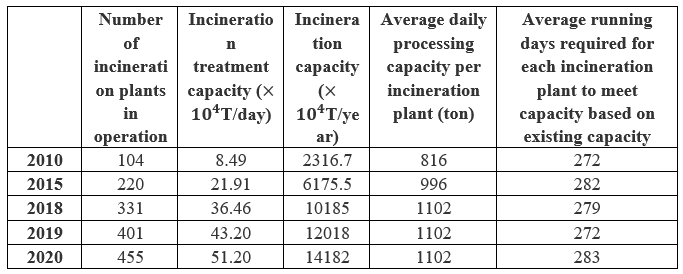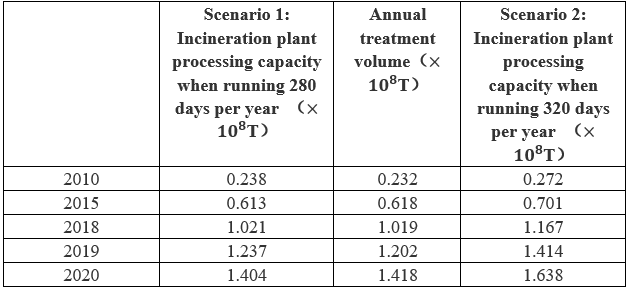

There are many factors to consider in evaluating whether there is a risk of excess waste incineration capacity during the 14th Five-Year Plan period. We will focus on the following four main factors:
1) Macroeconomic growth trend;
2) Urbanization development level;
3) Expansion of waste incineration capacity and scalability of existing capacity;
4) The impact of waste sorting and recycling policy on waste reduction.
The first three factors will be analyzed in this article, while the fourth factor will be discussed in the next article “When will the scale of waste incineration treatment peak?”.
Economic growth and urbanization level will affect the increase of municipal solid waste (MSW)
Economic growth will have a significant impact on household consumption and MSW production. Due to the impact of COVID-19, the GDP growth rate in 2020 has been highly uncertain. If the annual growth rate is assumed to be zero, the compound annual growth rate is likely to hover between 5%-6% during the 14th Five-Year Plan period, so let’s just assume the value is 5.5% here. Macroeconomic situation will affect the rising rate of urban population. The urban population increased from 666 million to 771 million in 2010-2015, with the annual compound growth rate 3.0%, and the proportion of urban population reached 56.10% in 2015.
Table 1: MSW volume, urban population and the proportion of different treatment methods in China

Source: China Statistical Yearbook; Note: Data for 2020 and 2025 are based on scenario analysis.
In 2019, the urban population increased to 848 million, accounting for 60.60%of the total population. With a compound annual growth rate of 2.4% from 2015 to 2019, assuming the same growth rate from 2019 to 2020, the urban population will reach 869 million by the end of 2020. The annual compound growth rate of urban population during the 13th Five-Year Plan period (2015-2020) was 20% lower than that during the 12th Five-Year Plan period (2010-2015). Assuming annual compound growth rate of urban population in 2020-2025 is 80 percent of the 13th Five-Year Plan level, or 1.9%, China's urban population will reach 945 million by 2025.
Different scenarios can be applied to analyze the impact on MSW volume caused by economic growth and urbanization level, assuming that during the 14th Five-Year Plan period (2021-2015), the annual compound growth rate of China's MSW volume and harmlessly-treated volume [1] is divided into two scenarios: A is the high growth scenario with a proportion of 6%, and B is the low growth scenario with a proportion of 4%. By 2025, the amount of waste treated harmlessly will reach 343 million tons and 312 million tons correspondingly. At the same time, assuming that the landfilling volume remains unchanged, the net increase of waste will flow to incineration. By 2025, waste incineration will reach 226 million tons (high growth scenario) and 195 million tons (low growth scenario).
Special attention should be paid to the assumption that waste disposal is still dominated by landfilling and incineration. Other treatment methods, such as waste sorting and recycling, are expected to bring significant changes in waste management in the 14th Five-year Plan, but this article will ignore them for the moment. We will discuss the impact of waste sorting and recycling policy in another article.
Elasticity of waste incineration capacity
China's incineration plants still have a lot of room to explore. Using the elasticity of China's waste incineration capacity at the end of the 13th Five-Year Plan helps measure the potential for capacity growth in the 14th five-year plan. The main factors affecting the elasticity of incineration capacity are the number of incineration plants and the average annual running time of each incineration plant. To facilitate calculation, this article adopts the annual operating days to calculate the incineration capacity.
As shown in Table 2, the rapid growth in the number of incineration plants since 2010 has led to a corresponding improvement in incineration treatment capacity. The incineration plant's daily processing capacity also increased from 816 tons in 2010 to 1102 tons in 2018. We assume that the average daily capacity of an incineration plant will remain at 1102 tons in 2020. The average annual growth rate of incineration capacity in 2019 and 2020 is consistent with the compound annual growth rate from 2015 to 2018, that is, 18%, and the incineration capacity in 2019 and 2020 will be 120.18 million tons and 141.82 million tons respectively. Incineration capacity has grown at a compound annual growth rate of 18.5% from 2015 to 2018. At this rate, incineration capacity will reach 432,000 tons/day in 2019 and 512,000 tons/day in 2020.
As of June 1, 2020, China has 455 incineration plants in operation. [2] During the 13th Five-Year Plan period, the compound annual growth rate of the number of incineration plants was 15.6%. Table 2 also shows that the average annual operating days per incineration plant has changed little over the past decade, fluctuating around 280 days.
Table 2: Overview of incineration treatment capacity

Source: China Statistical Yearbook; Note: the average daily processing capacity of each incineration plant is calculated according to the data in the preceding three columns.
Assuming that the average annual running days of Incineration plants in China can reach 320 days, the incineration treatment capacity will exceed the incineration volume by 22 million tons by 2020, which is equivalent to the amount of waste processed in 63 incineration plants with a daily treatment capacity of 1100 tons and an annual operation period of 320 days. Therefore, if the annual running days of the 455 incineration plants were increased from 283 to 320, it could avoid the construction of 63 incineration plants during the 14th Five-year Plan period.
Table 3: Comparison of annual waste incineration processing capacity and annual treatment volume

Source: China Statistical Yearbook; Rock Environment and Energy Institute;
Many new incineration plants are expected to begin operation by the end of 2020, and incineration capacity will continue to grow. Even with 455 incineration plants as a benchmark, the capacity of incineration plants has significant room for improvement in terms of running days, so policymakers should consider a priority policy option when formulating targets for waste management in the 14th Five-Year Plan, that is, the potential of maximizing existing incineration plants through improved processing capacity over the construction of new ones.
A reversed development of waste incineration?
In the next five years, China's MSW management will undergo great changes due to the implementation of sorting and recycling policies, and dry and wet taxonomy will directly lead to the reduction of incineration. Shanghai's waste sorting practice in the second half of 2019 showed that the amount of dry waste disposed of by the end of 2019 has decreased by 17.5% compared with the end of 2018. [3] The composition of waste entering incineration plants has changed greatly and the incineration efficiency has improved, but the incineration volume is decreasing. Will incineration continue to occupy a share of landfilling? How will this affect the waste incineration industry? For more discussion, please check our next article “When will the scale of waste incineration treatment peak?”.
Note:
[1]垃圾无害化处理利率2018年已经达到99.1%,本文假设2018年之后,垃圾无害化处理利率将达到99.9%。
[2]生态环境部公开2020年第一季度生活垃圾焚烧发电厂环境违法行为处理处罚情况。Link:http://www.envsc.cn/details/index/6714
[3]央视网新闻,“上海生活垃圾分类‘年报’出炉 分类效果正在显现”. Link: http://m.news.cctv.com/2020/04/29/ARTIWiWkWXX5jGK6aIaRyzL4200429.shtml [访问日期: 18 06 2020].
Author:Zhao Ang
Translation: Chen Shikai
Proofread: Pan Yiren
This article is an original article of the Rock Environment and Energy Institute. Please contact us to obtain the appropriate authorization to reprint. For cooperation and authorization, please send an email to: liying@reei.org.cn
* This is the translation of an article in Chinese. Should there be any inconsistency between Chinese and English version, the Chinese version shall prevail.




